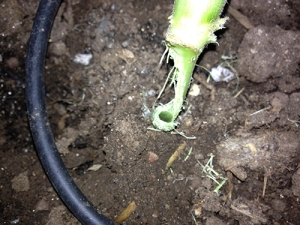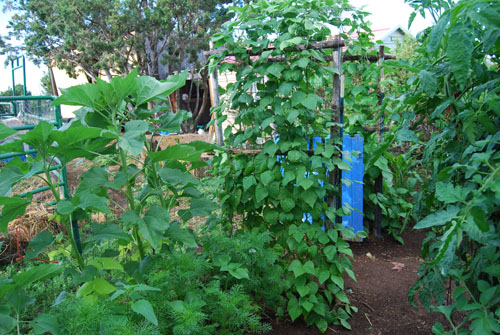
Here is the veggie garden in winter-now asleep
Happy Solstice! Yea-the days get longer now-and here it is the end of the year. As I look at winter, the first two months of winter-November-December are done and only two more months of winter (January-February) to endure. Then its early spring and off to the races! But let’s slow things down a bit. December is a great month to reflect on the gardening season and look at what worked and what didn’t work in the garden during the past year and what I might do differently.
So what worked and what didn’t?
-I only lost 10% of my tomato crops vs. last year’s 50 % tomato crop loss to the dreaded beet leafhopper. I covered almost all of my tomato plants with row cover from May 15th until the first week of July. The leafhopper leaves when the rainy season comes and this year they hung out till the beginning if July when it started raining. -The downside of this is I really don’t like NOT SEEING my plants hiding under the row cover-I like watching them grow, but that seems to be a tradeoff. Also I want to try to transplant my tomatoes outside earlier than May 15th to try to get tomatoes earlier.

-Rotating my crops seem to help with diseases. I have everything on a three-year rotation, which is why I made an additional 1000 sq ft section last year, giving me a total of (3) 1000 ft sections. I move the crops around so they only return to the same section every 3 years. The pumpkins use to have their own additional section in the horse corral but now that I have a horse (Koko), I will put them into the rotation in the main veggie garden since the corral has been reclaimed by Koko.
-Speaking of pumpkins, I need to find a way to keep critters from eating them although it was almost impossible to keep the rabbits away early in the season when food was hard to find for them-even with 2 fences and row cover over the pumpkins, something ate my prized potential pumpkin plant, so I’ll be thinking on that one a lot more this winter. Plus I want to get the plants outside earlier too if I’m to have a chance to break the state record again…
to keep the rabbits away early in the season when food was hard to find for them-even with 2 fences and row cover over the pumpkins, something ate my prized potential pumpkin plant, so I’ll be thinking on that one a lot more this winter. Plus I want to get the plants outside earlier too if I’m to have a chance to break the state record again…
-I covered my eggplants with row cover for a while this year thereby avoiding the first hail storm’s devastating damage. That first hail storm set back many of my vegetables due to the severe damage by about a month. The downside was aphids found the eggplants underneath the row cover and it was a battle to get rid of them. The aphids also went after the summer squash and peppers with all the rain we got. I controlled them with strong sprays of water on them and insecticidal soap. Also lady bugs appeared and came to the rescue eating many aphids (and I didn’t have to buy them). I think I need to remove the row cover earlier.
The almost finished greenhouse was unbelievably hot last summer-110°F. Too hot to grow anything which was ok as it wasn’t ready anyways. So after I work to button it up this winter, I will have to find ways to cool it down next summer. Still, I have a greenhouse! I’ll take the challenges it will present.
 -I have to say I enjoyed all the rain we got after 4 years of an extreme drought. The fruit trees loved all the rain but 2 more hail storms almost wiped out the vegetable crops especially the chard and squash. It was amazing anything survived plus the one week of rain that we got-about 3 inches-watered down the flavor of the tomatoes for about 2 weeks but then they bounced back.
-I have to say I enjoyed all the rain we got after 4 years of an extreme drought. The fruit trees loved all the rain but 2 more hail storms almost wiped out the vegetable crops especially the chard and squash. It was amazing anything survived plus the one week of rain that we got-about 3 inches-watered down the flavor of the tomatoes for about 2 weeks but then they bounced back.
Most of the problems came from Mother Nature and there is not much one can do about her-she does what she wants and we need to adjust. We always think we have everything in control and then wham! She does a number on us!
-I will grow more tomato plants and other veggies to sell at the Farmer’s Market as many people seemed excited to try some of the different varieties I grow. To this effect, I think the greenhouse will be great asset this spring.
So now I will be going over all the catalogs that are coming in and start to plan the veggie garden for 2014.
Happy Holidays!
–
 Tomorrow night a freeze warning has been issued for our area in Santa Fe.
Tomorrow night a freeze warning has been issued for our area in Santa Fe.






















